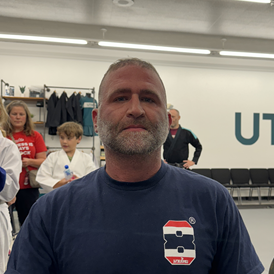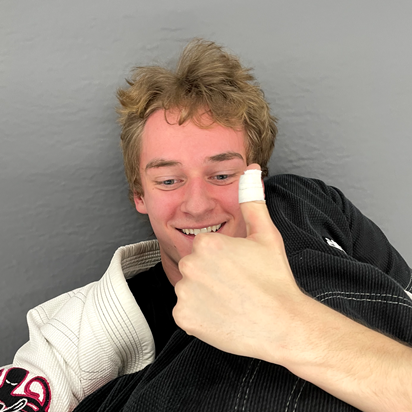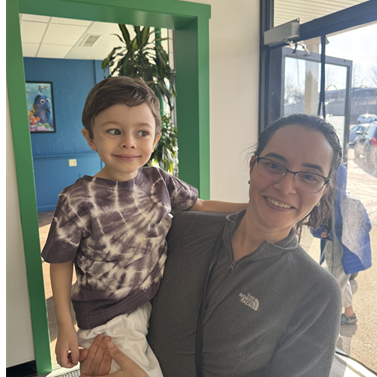 Many people mistakenly believe that Brazilian Jiu-Jitsu (BJJ) is just for young athletes with extensive martial arts backgrounds. However, these misconceptions couldn’t be further from the truth. BJJ is an incredibly dynamic martial art that provides immense physical and mental benefits for beginners of all ages and abilities. While some worry they are “too old” to start training, the truth is that it’s never too late to learn BJJ, overcome perceived limitations, and experience major improvements in fitness, self-defense skills, mental sharpness, stress relief, and so much more.
Many people mistakenly believe that Brazilian Jiu-Jitsu (BJJ) is just for young athletes with extensive martial arts backgrounds. However, these misconceptions couldn’t be further from the truth. BJJ is an incredibly dynamic martial art that provides immense physical and mental benefits for beginners of all ages and abilities. While some worry they are “too old” to start training, the truth is that it’s never too late to learn BJJ, overcome perceived limitations, and experience major improvements in fitness, self-defense skills, mental sharpness, stress relief, and so much more.
Misconceptions Around Age Limitations
“I’m too old to start.” “I’m not athletic enough to keep up.” “I have no martial arts experience.” These are common concerns from adults interested in BJJ but hesitant to sign up for classes. Many worry that they lack the attributes to succeed, especially if they are starting later in life without a foundation in martial arts.
However, the fundamental truth is that Brazilian Jiu-Jitsu can benefit people at any age. The techniques use leverage, angles, and proper body mechanics so that any individual can learn to defend themselves and submit to opponents regardless of size, strength, or athleticism. Stripped down to its core principles, BJJ is extremely adaptable for all populations.
While kids who start early often progress quickly, adults can also start BJJ as beginners. It simply requires finding the right gym, learning proper techniques, tapping into quality instruction, and making incremental progress. With an open mindset and determination, adults can overcome perceived physical limitations and excel in BJJ.
Adapting to Different Fitness Levels
One of the most common concerns prospective adult students have is needing more fitness or physical attributes. Many worry that sparring or grappling will be too intense for them, especially if they are starting a fitness journey. However, BJJ training can be scaled to accommodate any individual’s abilities.
At the beginner level, training is focused on developing core techniques like hip escapes, shrimping, and establishing strong positions. While these drills do build physical endurance over time, the starting emphasis is on proper form and repetition to ingrain muscle memory. Advanced techniques like inversions and takedowns come later after building a base.
Later on, live grappling during sparring sessions is done at varying intensities. Instructors will match you with training partners at similar skill and fitness levels. The speed and resistance can be adjusted as needed for beginner students. The focus is always on learning in a safe, controlled manner.
Additionally, many academies offer “fundamentals” classes focused purely on drilling techniques at a moderate pace. This allows newer students to get quality mat time without the intensity of sparring. There are also options to attend several weekly classes based on your schedule and recovery needs.
The right academy will encourage you to progress at your own pace, focusing on small, incremental goals. Paying close attention to instructor feedback and tapping early/often prevents injury as your body adapts. Starting BJJ can motivate you to improve your fitness to progress further, and any beginner can start from day one regardless of current athletic capabilities.
Progressing Without Prior Martial Arts Experience
Another common misconception is that you need years of experience in arts like Judo or Karate to start Jiu-Jitsu. However, BJJ was specifically designed for smaller, weaker individuals to be able to control and submit to larger opponents. The system relies heavily on leverage and technique rather than brute strength or striking ability.
This makes BJJ extremely beginner-friendly compared to other martial arts. Previous experience is optional, and fundamentals classes focus on teaching basic movements, body positioning, and submissions from the ground up. You will not be thrown into an advanced sparring match on day one. The progression is intentional, giving you time to absorb instruction, drill techniques, and put concepts into practice with appropriate training partners.
Instructors are there to provide guidance, answer questions, and curate your development. They will prevent you from attempting anything too advanced before you build the necessary skills. Showing up with zero martial arts experience means you have no bad habits to unlearn, and you can progress rapidly through the BJJ belt system by dedicating yourself to learning.
While humbling at first, leveling up your skills as an absolute beginner is highly rewarding. Setting small, achievable goals will help you measure your consistent improvement. Focus on listening, learning, drilling, and tapping early and often to prevent injury. With an open student mindset, you can gain competency much faster than trying to fake experiences you do not have. Lean into being a beginner while trusting the proven teaching systems.
BJJ for All Ages
Some adults worry they are too old to learn new martial arts. Concerns around flexibility, recovery from injuries, or the ability to retain techniques may hold them back. However, Brazilian Jiu-Jitsu has been proven effective for students across all age brackets. The adaptability of BJJ allows techniques to be modified based on abilities and limitations.
While younger students may rely on speed and reflexes, older students can focus more on establishing dominant positions and using leverage. BJJ relies heavily on problem-solving on the fly during a roll, which benefits from the critical thinking skills adults develop with age and experience. The technical knowledge accumulated over years of training can offset any loss in reaction times or explosiveness.
Training with a mix of partners across different age groups is beneficial as you learn how opponents of all ages move and can adjust your strategies accordingly. Older students also tend to have increased mental patience, so rather than muscling techniques, they focus on getting the intricate details just right. Quality and precision come with experience.
Instructors can advise on modifications to avoid injuries and frustration. These would include; tap early and often, and do not try to muscle through techniques using strength. While injuries can happen at any age, being attentive to tap before pain kicks in is key. Listen to your body and scale back if needed. The goal is longevity through a lifetime of training; pace yourself, and the benefits will compound.
The gym environment is also a major factor in safety for older trainees. Finding an academy focused on inclusive learning rather than competition intensity is best. Avoid any gym culture that encourages ego-driven sparring battles. Though challenging yourself is growth, match your pace first and foremost to your development rather than comparing to others.
Making Progress with Limited Training Time
Adults looking to begin BJJ often have pressing demands on their time, between work obligations, family responsibilities, and other priorities. Many worry they cannot commit to frequent, intense weekly training sessions. However, it is entirely possible to integrate BJJ into busy adult life and make steady progress.
Training just two or three days per week is enough for beginners. Fundamentals classes allow you to ingrain proper technique through drilling. At reputable academies, instructors will ensure you are not thrown into intense sparring before understanding core concepts. Attending consistent open mat sessions allows you to troubleshoot techniques through live rolling at your own pace.
To prepare at home, use solo drills to work on motions for arm bars, chokes, and escapes. Visualization is also useful: watch instructional videos to understand combinations, transitions, and strategies. This mental preparation will help you hit the mat ready to implement techniques. Becoming familiar with basic movements outside of class allows you to make each session as efficient and productive as possible.
As your schedule permits, consider supplementing with strength training for injury prevention. At-home exercises that target core strength, flexibility, and balance will pay dividends. This additional conditioning extends your longevity in BJJ as your body adapts to the demands. But even without major strength training, showing up consistently will improve your physique.
Focus sessions on executing a few techniques correctly rather than attempting to master dozens of complex maneuvers. It is better to drill a smaller subset of attacks and defenses until they become muscle memory. A focused, precise approach suits limited training time. Remain patient, as plateaus are normal when learning intricate skills. Breakthroughs follow soon after.
Physical Fitness Benefits
While Brazilian Jiu-Jitsu is a highly effective self-defense system, the physical benefits make it worth starting as an adult. BJJ provides an incredible full-body workout utilizing every muscle and energy system in your body. The constant grappling exchanges build maximal strength, anaerobic endurance, flexibility, and coordination simultaneously.
Compared to striking styles, BJJ allows beginners to train at high intensity relatively safely. Tapping out ends exchanges before injury occurs. Under instructor supervision, you can push your limits, growing stronger and more conditioned. Sparring sessions will elevate your heart rate and build cardio endurance better than treadmills or bikes.
Drilling techniques demand a deep focus on proper hip and arm positioning. Holding stances strengthens the core and stabilizer muscles. The static and dynamic stretching involved increases the range of motion. Simply showing up consistently will sculpt muscle and shred fat. Gi training, in particular, builds killer grip strength.
The constant rolling and tumbling improves proprioception and body control. Shooting for takedowns requires explosive power. All of these benefits compound over time to dramatically improve overall functional fitness. Starting BJJ can provide the motivation needed to achieve your fitness goals.
Gaining Real-World Self-Defense Skills
Learning effective self-defense skills is often a major reason adults finally sign up for martial arts. While exercise benefits are great, students want to feel confident protecting themselves in real-world scenarios. The mat provides a place to test techniques at full speed and resistance safely.
BJJ is designed specifically for smaller individuals to control larger, stronger opponents. Practitioners learn leverage-based techniques that require minimal strength to execute, whether standing or on the ground. Proficient students can quickly end violent encounters through submission holds or incapacitating joint locks.
With consistent sparring against fully resisting partners, you gain experience improvising under pressure. This makes remaining calm while attempting to establish dominant positions instinctual. This ability to perform under adrenaline in training translates directly to real situations.
The conditioning needed to grapple through 5-minute rounds builds mental fortitude. You quickly adapt to physical discomfort and fatigue. Getting comfortable in “uncomfortable” positions develops mental toughness. These intangibles are invaluable in managing the stress of real confrontations.
BJJ also addresses common scenarios like front chokes, bear hugs, headlocks, and tackles. Drilling escapes from inferior positions prevents panic when taken down in a fight. While no martial art can guarantee victory, lifelong BJJ practitioners will have the skills to defend themselves in most life-threatening situations if needed.
Enhancing Mental Sharpness
The physical components of Brazilian Jiu-Jitsu provide an incredible full-body workout. However, the mental benefits of consistent training may be even more substantial. The intellectual stimulus of learning intricate systems has paid dividends over decades. As a “physical chess match,” BJJ helps sharpen the mind just as much as the body.
The constant problem-solving during sparring requires extreme presence of mind. You must read your opponent’s balance and intention to create openings. Executing multi-step sequences demands concentration. Controlling the pace and setting traps requires strategic thinking. Every role challenges mental flexibility.
Over time, practitioners develop keen spatial awareness and reaction times. Processing variables and making split-second decisions becomes instinctual. The ability to perform smooth techniques under extreme duress has a huge crossover to demanding “mental performance” scenarios at work or in life.
Trying to keep up with the endless techniques also exercises the memory; higher belts can know hundreds of interconnected attacks, counters, sweeps, and escapes. Retaining and integrating this knowledge base keeps the mind sharp.
Finally, learning from qualified instructors requires humility, open-mindedness, and grit. Listening intently, applying feedback, and working through plateaus will pay dividends in all pursuits. The introspection needed to improve technique strengthens character and life wisdom.
Cathartic Stress Relief
It is no secret that daily stresses can build up, from work anxiety to emotional struggles. Many adults deal with this pressure in unproductive ways, from overeating to drinking too much alcohol. BJJ provides a healthy, cathartic release, allowing you to grapple with your “demons” on the mats.
The intense exertion required to train lets you channel negative emotions productively. You can exhaust your tensions and frustrations through cardiovascular conditioning and resistance training. Pushing through discomfort builds mental toughness to manage life’s inevitable challenges.
The adrenaline rush of sparring forces you into an instinctual “flow state.” All outside worries fade away as you focus energy completely on the immediate task. The present moment demands full attention. This can provide meditation-like calm and clarity.
Having a consistent positive community also promotes mental well-being. Socializing before and after class is a great stress reliever. Laughter naturally increases endogenous opioids and dopamine, so joking with training partners gives the overall mood a healthy boost.
Furthermore, respectful academies strictly prohibit any ego or negativity on the mats. This positive culture allows you to feel psychologically safe, and with trust in your training partners, you can confidently take the risks needed to advance, letting your fears fade away.
Finding Community & Camaraderie
For many adults, schedules become busier over the years between work, family, and other obligations. Finding time to maintain an active social life can be challenging. Joining a BJJ gym provides built-in camaraderie with like-minded peers. The shared intensity of training generates natural bonds.
Partners will celebrate your successes, like hitting a new technique. You will mutually commiserate over hard matches and form lifelong friendships through this shared journey.
Having an inclusive group to learn alongside increases motivation and accountability. You quickly become invested in not only your own success, but also your training partners’. Showing up consistently to work together gets easier when you feel part of a team.
Training also builds emotional intelligence. BJJ requires respecting teammates’ physical safety, and practicing empathy and patience in learning generates trust. Leaving ego aside makes gentle communication natural. These social skills transfer positively to all relationships.
Finally, the culture of paying it forward creates a special atmosphere. Advanced students eagerly mentor newer members just as others guide them. The cycle of contribution keeps gyms engaging and supportive. You will feel welcome with open arms, regardless of age or background.
Starting Slow as a Beginner
Once you commit to start training, it is tempting to want to skip ahead and learn fancy techniques. However, slowly building your skill base as a beginner is crucial to long-term progress and avoiding injury. Have patience, knowing advanced moves will come in time.
The first six months should focus almost exclusively on escapes and defenses. Surviving inferior positions is the key to building confidence. Attempting submissions too early often backfires. Gain control first before trying any attacks.
Drill essential movements like bridging, shrimping, and framing religiously. Master your arm bars and cross chokes. Learn how experienced players break grips and retain guard. Start to understand strategies for breaking posture and off-balancing opponents.
Get comfortable with positions such as the different guard variations and work escapes from common pins like side control and mount. Developing a strong foundation will pay dividends once you start combining techniques. Be patient and let your instructor guide you on when to level up.
Tapping Early, Tapping Often
The phrase “tap early, tap often” is often repeated when offering advice to BJJ beginners. This means submitting promptly before getting stuck in a submission you cannot escape. It is vital to protect your body as techniques become more complex.
Some people’s ego tempts them to try and “power through” maneuvers, grinding their limbs to avoid tapping. There is no shame in conceding – it allows you to reset and explode again fresh on the next round. Know your limits, and do not let training partners crank techniques to the point of injury before tapping. Ease up if you feel joints overextending. Ultimately, your long-term health is most important.
It would be best to learn the subtle differences between pressure and pain. Discomfort is expected, but serious pain means damage is imminent. Tap immediately if a submission elicits sharp, radiating pain instead of general soreness.
Trust that frequent tapping will pay off as your defense improves. What seems impossible to escape today becomes second nature after months of training. Persisting through pain leads to time off the mats. Patience prevents injury.
Asking Questions & Modifying Techniques
Brazilian Jiu-Jitsu has a vast library of techniques between gi and no-gi training. As a beginner, trying to research and understand everything will quickly lead to information overload. Follow your instructor’s lead on what to focus on learning first.
Do not hesitate to ask questions whenever you are confused. Whether it is a detail on hand positioning or the purpose of an unfamiliar movement, speaking up will get you answers. You want to engrain proper technique early before bad habits set in.
Also, inform your instructor if you have any injuries or limitations so they can provide modifications. For example, those with previous knee operations can drill passes from headquarters to reduce pressure. There are always workarounds.
Open communication allows the instructor to tailor your development based on unique needs. Be transparent about any techniques you find awkward or painful so they can troubleshoot. There is no one-size-fits-all formula, so personalization is key.
The cumulative knowledge of your academy’s professors has been refined over decades. Trust their judgment on what will progress your game most efficiently. Leave your ego at the door and embrace being a beginner student.
Setting Measurable Short-Term Goals
On your first day walking through the doors of an academy, achieving a black belt may seem like an impossible undertaking. The key is to set much smaller, incremental goals that mark your progress from session to session. Mini milestones maintain motivation.
A beginner’s first goal may be to learn two fundamental armbar setups from the guard. The next goal could be chaining your favorite sweep into an armbar attempt when the opponent bases out. Achieving well-defined objectives keeps you progressing.
Write down techniques and tactics you attempt in rolls. Analyze what worked versus mistakes to revisit. Keep track of submissions you attempt and your success rate. Slowly raising this finishing percentage over time marks improvement, even if you are still being submitted more.
On benchmark days like belt promotions or in-house tournaments, set performance targets like attempting five submissions or sweeping three times. Having an intentional plan prevents flailing randomly. Even incremental gains in skill translate into clear markers of development over months and years of work.
It is also helpful to identify weaknesses and set goals around improving them. If you often get stuck in side control, dedicating sessions to escaping can become your focus. Developing your weakest positions pays dividends. Winning in rolls is a byproduct of eliminating holes through targeted training.
Most importantly, measure progress against yourself rather than your teammates. Focus on becoming 1% better each week while avoiding direct comparison. Your path is unique, so celebrate hitting personal goals regardless of those around you. Consistency, patience, and self-analysis will bring steady gains over time.
Training with the Right Partners
Good training partners are invaluable to developing your skills efficiently as a beginner. Rolling with teammates who match your intensity and experience level accelerates your progress. Seek out those who will challenge you while avoiding injury.
Higher belt levels should have the control to turn up or down the intensity based on your needs. Drilling techniques at 50% speed with these experienced partners ingrain proper mechanics. They can provide just enough resistance to sharpen your technique without overpowering you.
When free sparring, clearly communicate your goals so they can adjust accordingly. For example, requesting they play closed guard allows you to practice standing passes. Or asking them to start from a side mount allows you to work escapes.
Partners interested in mutual growth will offer openings to work attacks while defending submissions reasonably. Sparring rounds should simulate matches while avoiding excessive force. You can push each other productively within safe limits.
Rolling with athletic, motivated peers of a similar rank is also vital. You can evolve together through matches with no clear favorite. Challenging each other to implement new techniques accelerates the learning curve. Progress together.
Focusing On Your Development
It can be demoralizing as a new BJJ student when you find yourself submitted constantly against more experienced teammates. The key is to avoid fixating on “winning” or losing rolls, especially in your first year. Matches are solely about engraining skills through experience.
That purple belt submitting you has likely trained for years to develop that technical proficiency. It will require time and dedication for you to close that gap. But your only benchmark for progress should be your improvement day to day.
After rolls, reflect on what positions and attacks worked well for you or created openings. Identify areas you got stuck so you can strengthen them. Celebrate small wins like escaping a tricky submission or passing to side control against solid guards.
Every rep spent drilling, scrambling in rolls, and taking falls getting taken down hones muscle memory. Failures teach even more than successes if you take the time to analyze. Lost rounds make for the most growth.
Measure your performance against past versions of yourself rather than your teammates. Are your movements getting more precise each month? Can you reliably hit techniques now that you flailed at before? That feeling of skills “clicking” as they become instinctual through mat time is the real progression marker.
Finding the Right Academy Environment
Choosing the proper academy is incredibly important when starting BJJ as an adult. Unfortunately, some gyms promote macho attitudes or egos, which can jeopardize the safety of new students. Prioritize a beginner-friendly environment focused on technical growth.
The culture should emphasize teamwork and community over individual status. There should be no “hazing” of new members or over-aggressive sparring meant to dominate. Look for an atmosphere of collaboration and mutual improvement.
A mix of ages, body types, and experience levels in classes prevents intimidation. Everyone should feel comfortable learning at their own pace. Upper belts should guide newer students, not attempt to destroy them.
Instructors should provide careful supervision of sparring to prevent injuries. Given your size, strength, and current ability, they will match you with appropriate partners. Open communication should be encouraged.
There should be no attitude that quitting is a weakness or shameful. Members should understand if life circumstances ever require you to pause. Signs of ego, like resentment of taps or unsafe aggression, are unacceptable.
Ultimately, seek a gym that fits your personality and goals. A hyper-competitive atmosphere may work for some but discourage others. The right environment leads to longevity in your BJJ journey.
If you are in the Grafton, WI, area, check out . Our world-class instructors, beginner-friendly culture, and inclusive community make it the perfect environment for adults to start Brazilian Jiu-Jitsu.
Just Get Started





































































